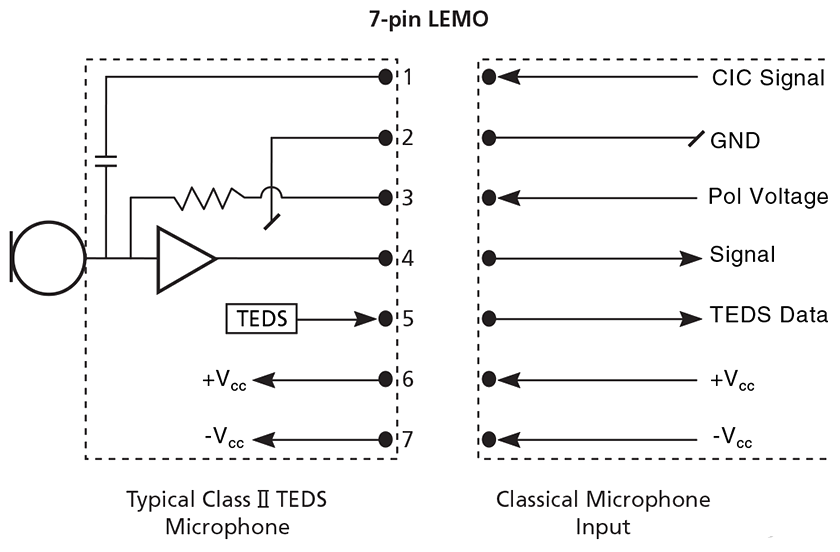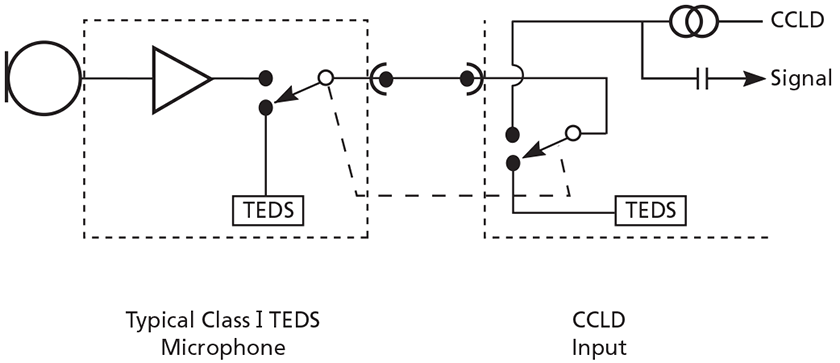LEARN MORE
SIGNAL CONDITIONING
AND AMPLIFICATION
A wide range of TEDS (Transducer Electronic Data Sheet) microphones are available from Brüel & Kjær. A TEDS microphone consists of a microphone cartridge and a built-in microphone preamplifier, sealed to form a single unit called a TEDS microphone.
TEDS is standardized by IEEE and is supported by many front ends and signal conditioning amplifiers. This includes our LAN-XI Data Acquisition System, the NEXUS line of Conditioning Amplifiers, the 16-channel Conditioning Amplifier Type 2694, and others.
Designing and manufacturing all parts of the measurement chain ourselves gives unique integration benefits for the user. As an example, our LAN-XI Data Acquisition Systems automatically reads the data stored inside the transducer (when using TEDS-enabled sensors).
Benefits of TEDS
- Plug and play facilities
- Type, S/N, sensitivity, and more read indirectly from the transducer
- Significantly reduced setup time
- Practical elimination of cable routing errors
- Transducer location can be read into the transducer
- The TEDS microphone is assembled under controlled conditions
How does TEDS work?
Basically, the chip containing the TEDS data and TEDS interface is built into the microphone preamplifier. TEDS data is updated during the boot sequence or whenever “update TEDS” is activated.
TEDS data can be transmitted to the front-end in two different ways:
- Class I TEDS – on the same wire as the analog signal
- Class II TEDS – via a separate wire
Class I is always used with DeltaTron transducers since TEDS can be implemented using the traditional coaxial cable. For measuring microphones, Class II is the most commonly used and pin 5 (often denoted as “No connection” in PDs) is used to transmit the TEDS data. This is important when using extension cables as some older cables might really not have pin 5 connected, which will break the TEDS chain.
Since the TEDS microphone has been assembled under controlled conditions, special precautions can be taken to avoid dust and contamination entering the boundary between the microphone cartridge and the preamplifier. This is important in order to maintain low noise even at high temperatures and high relative humidity.

IEEE 1451.4 Standard
Most sound and vibration transducers (Brüel & Kjær as well as other manufacturers) conform with IEEE P1451.4V.0.9 which is actually a standard proposal and differs slightly from the final standard IEEE 1451V.1.0.
LEARN MORE
TRANSDUCERS FOR
SOUND AND VIBRATION
Remapping to IEEE1451V.1.0 is available for all Brüel & Kjær transducers as part of after-sales support. Relevant Brüel & Kjær hardware (LAN-XI, PULSE, NEXUS, etc.) supports both the proposed and final version of the standard, and in many applications, the user will not notice a difference between the two standards.
The major difference between the proposed and final versions concerns the memory map. In the proposed version, all data is in an R/W area of the memory, while in V.1.0 some permanent data (manufacturer, etc.) has been moved to a write-once area of the memory. This leaves more space in the so-called user area of the memory.
Currently, only our 10 kHz Array Microphone Type 4957 and our 20 kHz Precision Array Microphone Type 4958 are supplied with TEDS according to the final revision – IEEE 1451.4V.1.0. This is because precision Array Microphone Type 4958 requires more space for the definition of the polynomial describing the complex transfer function.
TEDS Templates
The TEDS template defines the memory mapping of the TEDS chip and hence the “understanding” between transducer and front-end. A number of TEDS templates have been standardized by the IEEE and in addition to this, a number of non-standard vendor-specific templates exist.
The different TEDS templates are differentiated by different ID numbers. At the moment Brüel & Kjær uses the following templates for TEDS microphones and preamplifiers:
| UTID. No. | Name | Remarks |
|---|---|---|
| 34013408 |
Microphone with integrated preamplifier | Used for Array Microphones Types 4935 and 4951. This template is with transfer function |
LEARN MORE
MICROPHONE SET /
TEDS MICROPHONES
|
UTID. No. |
Name | Remarks |
|---|---|---|
| 769 |
Microphone, integrated preamplifier | Used for most TEDS microphones |
| 1025 | Microphone preamplifier | Used for most TEDS microphone preamplifiers |
| 116289 |
Microphone, integrated preamplifier, extended sensitivity | Used in special cases like low-sensitivity microphones or reference frequency, not 250 Hz |
| UTID. No. | Name | Remarks |
|---|---|---|
| I27-0-0-0U |
Microphone with an integrated preamplifier, V.1.0 |
This template is without transfer function. Replaces UTID 769 and 116289 |
| I27-0-0-1U |
Microphone with an integrated preamplifier, transfer function, V.1.0 |
Same as UDID 127-0-0-0U but with transfer function. Replaces UTID 34013408 |
TEDS Microphone Specifications
For detailed specifications please refer to the product datasheets for the individual components. Unless otherwise stated all specification in this table are valid under the following conditions:
- DeltaTron input types: 24 – 28 V compliance voltage
- Classical input types: 120 V DC supply*
- Dynamic range low limit: Noise floor dBA
- Max. SPL dB: The 3% distortion limit in dB SPL RMS rounded to the nearest integer. The undistorted peak level will normally be 3 dB higher
- Cartridge sensitivity: Nominal
Get expert advice about B&K microphones
TEDS Microphone Sensitivity
Stated as the nominal cartridge sensitivity except for ¼-inch and 1/8-inch cartridges where the loaded sensitivity differs considerably from the open circuit sensitivity.
* As an example, the supply voltage to a classical preamplifier is reduced from 120 V to 28 V or ±14 V the max. SPL may theoretically be reduced by up to 15.7 dB
Temperature Range for TEDS
The read-write temperature range of the TEDS chip is guaranteed by the chip manufacturer up to +85°C only (185°F) but the TEDS chip will survive the full specified temperature range of the TEDS microphone/preamplifier without any damage.
TEDS and Cable Length
TEDS is guaranteed to work properly with cable length up to 100 m (328 ft). Brüel & Kjær preamplifiers can drive very long cables. The cable length is limited though by the available output current of the preamplifier, especially in situations where high-frequency signals must be measured at high levels.
Making TEDS Smarter
Transducer Smart Setup is a mobile application that works in combination with data matrix codes (similar to QR codes™) on transducers. It's job? To simplify and automate multi-channel test setups, giving you instant access to specifications and calibration information.
Download Transducer Smart Setup

Iscriviti alla nostra Newsletter e ricevi le informazioni più recenti dal mondo del suoni e delle vibrazioni



